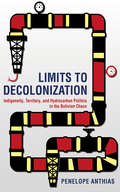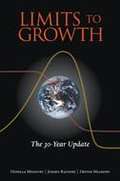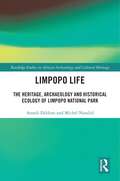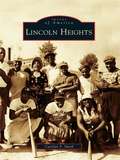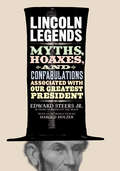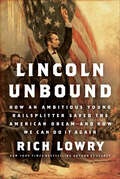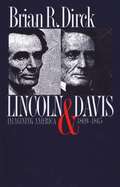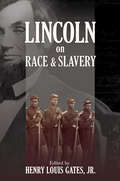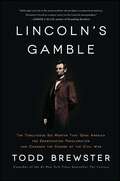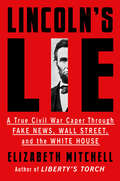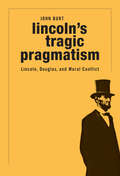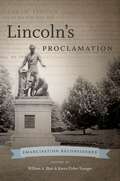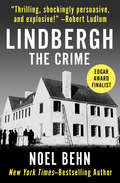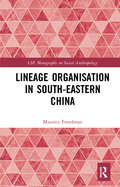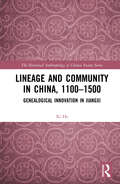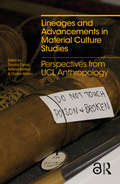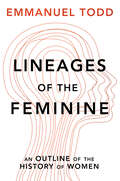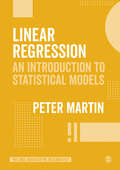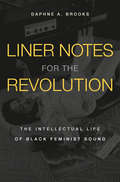- Table View
- List View
Limits to Decolonization: Indigeneity, Territory, and Hydrocarbon Politics in the Bolivian Chaco (Cornell Series on Land: New Perspectives on Territory, Development, and Environment)
by Penelope AnthiasPenelope Anthias’s Limits to Decolonization addresses one of the most important issues in contemporary indigenous politics: struggles for territory. Based on the experience of thirty-six Guaraní communities in the Bolivian Chaco, Anthias reveals how two decades of indigenous mapping and land titling have failed to reverse a historical trajectory of indigenous dispossession in the Bolivian lowlands. Through an ethnographic account of the "limits" the Guaraní have encountered over the course of their territorial claim—from state boundaries to landowner opposition to hydrocarbon development—Anthias raises critical questions about the role of maps and land titles in indigenous struggles for self-determination.Anthias argues that these unresolved territorial claims are shaping the contours of an era of "post-neoliberal" politics in Bolivia. Limits to Decolonization reveals the surprising ways in which indigenous peoples are reframing their territorial projects in the context of this hydrocarbon state and drawing on their experiences of the limits of state recognition. The tensions of Bolivia’s "process of change" are revealed, as Limits to Decolonization rethinks current debates on cultural rights, resource politics, and Latin American leftist states. In sum, Anthias reveals the creative and pragmatic ways in which indigenous peoples contest and work within the limits of postcolonial rule in pursuit of their own visions of territorial autonomy.
Limits to Growth: The 30-Year Update
by Jorgen Randers Dennis Meadows Donella MeadowsJust over 30 years ago a path-breaking book was published called "The Limits to Growth." It posited the then controversial idea that unlimited growth on a finite planet would inevitably lead to ecological collapse. The book was translated into more than a dozen languages. Now "Limits to Growth: The 30 year Update" takes the analysis into the first decade of the 21st century to show that while the situation remains precarious, there is still time to bring the Earth back from the brink of ecological collapse.
Limpopo Life: The Heritage, Archaeology and Historical Ecology of Limpopo National Park (Routledge Studies in African Archaeology and Cultural Heritage)
by Anneli Ekblom Michel NotelidLimpopo Life introduces the reader to the material culture, oral histories, and the negotiation of conservation and landscape in an area now known as Limpopo National Park.Introducing the archaeology of a region that has not been surveyed or discussed, this book connects to the archaeology, history, heritage and conservation discussions in the southern African region as a whole. Vegetation history and paleoecology are combined with archaeological surveys and excavations, written sources, oral histories and travelogues to draw a picture of the diverse landscape of the Limpopo region. Intermixed within this narrative are sections that focus on an individual species, a life history, or an event providing a view of the complex and dynamic interactions. The role of humans in this diverse environment and how they have co-evolved with other species, shaping each other's destinies in a consequential and accidental way, is outlined.This book will be of interest to researchers and students interested in the archaeology, heritage and conservation of Mozambique, Zimbabwe and northern South Africa. It will also be of relevance to readers interested in the social history of the Limpopo and Kruger National Parks and this cross-border area.
Lincoln Heights (Images of America)
by Carolyn F. SmithLocated north of Cincinnati in the Mill Creek Valley, Lincoln Heights was the first African American self-governing community north of the Mason-Dixon Line. The development of Lincoln Heights began in 1923 when the Haley-Livingston Land Company of Chicago sold lots to black families in an unincorporated area called the Cincinnati Industrial Subdivision, now the southern section of Lincoln Heights. Water and sewerage were provided by special assessment through the Works Progress Administration, there were no building and zoning code services, fire and police protection were virtually nonexistent, and street maintenance and lighting were extremely inadequate. In 1939, residents of the area began efforts to incorporate so they could provide safety and necessary services for their growing community. Several of the original petitioners for incorporation lived in the Valley View subdivision, which later became the Wright Aeronautical plant, where many black migrants from the South came to help manufacture the famous B-29 bomber.
Lincoln Legends: Myths, Hoaxes, and Confabulations Associated with Our Greatest President
by Edward Steers Jr.&“Succinctly and eloquently debunks 14 popular myths about the Great Emancipator's life and death [with] solid documentation.&” —Publishers Weekly In the more than 150 years since his death, Abraham Lincoln has become America&’s most revered president. The mythmaking about this self-made man began early, some of it starting during his campaign for the presidency in 1860. As an American icon, Lincoln has been the subject of speculation and inquiry as authors and researchers have examined every aspect― personal and professional ―of the president&’s life. In Lincoln Legends, noted historian and Lincoln expert Edward Steers Jr. carefully scrutinizes some of the most notorious tall tales and distorted ideas about America&’s sixteenth president. Did he write his greatest speech on the back of an envelope on the way to Gettysburg? Did he appear before a congressional committee to defend his wife against charges of treason? Was he an illegitimate child? Did he have romantic encounters with women other than his wife—or love affairs with men? What really happened in the weeks leading up to April 14, 1865, and in the aftermath of Lincoln;s tragic assassination? Lincoln Legends evaluates the evidence on all sides of the many heated debates about the Great Emancipator, and also traces the often fascinating evolution of flawed theories about Lincoln and the motivations of the individuals―occasionally sincere but more often cynical, self-serving, and nefarious―who are responsible for their dispersal. Based on extensive primary research, Lincoln Legends will settle many of the enduring questions and persistent myths about Lincoln&’s life once and for all. &“Fascinating reading.&” —Tucson Citizen
Lincoln Unbound: How an Ambitious Young Railsplitter Saved the American Dream---And How We Can Do It Again
by Rich LowryIn this thoughtful mix of history and politics, the New York Times bestselling author and editor of National Review—the conservative bible founded by William F. Buckley, Jr.—traces Abraham Lincoln's ambitious climb from provincial upstart to political powerhouse and calls for a renewal of the Lincoln ethic of relentless striving.Revered today across the political spectrum, Abraham Lincoln believed in a small but active government in a nation defined by aspiration. Fired by an indomitable ambition from a young age, the man who would be immortalized as the "railsplitter" never wanted to earn his living with an ax. He educated himself in a frontier environment characterized by mind-numbing labor and then turned his back on that world. All his life, he preached a gospel of work and discipline toward the all-important ends of self-improvement and individual advancement. As a Whig and then a Republican, he worked to smash the rural backwardness in which he was raised and the Southern plantation economy that depended on human bondage.Both were unacceptably stultifying of human potential. In short, Lincoln lived the American Dream and succeeded in opening a way to it for others. He saw in the nation's founding documents the unchanging foundation of an endlessly dynamic society. He embraced the market and the amazing transportation and communications revolutions beginning to take hold. He helped give birth to the modern industrial economy that arose before the Civil War and that took off after it.His vision of an upwardly mobile society that rewards and supports individual striving was wondrously realized. Now it is under threat. Economic stagnation and social breakdown are undermining mobility and the American way. To meet these challenges, Rich Lowry draws us back to the lessons of Lincoln. It is imperative, he argues, to preserve a fluid economy and the bourgeois virtues that make it possible for individuals to thrive within it.
Lincoln and Davis: Imagining America, 1809-1865
by Brian R. DirckAbraham Lincoln: the Great Emancipator, savior of the Union, and revered national hero. Jefferson Davis: defender of slavery, leader of a lost cause, and forlorn object of scorn. Both Lincoln and Davis remain locked in the American psyche as iconic symbols of victory and defeat. They presided over a terrible war that decided the fate of slavery and severely tested each man's resolve and potential for greatness. But, as Brian Dirck shows, such images tend to obscure the larger visions that compelled both men to pursue policies and actions that resulted in such a devastating national tragedy. Going well beyond most conventional accounts, Dirck examines Lincoln's and Davis's respective ideas concerning national identity, highlighting the strengths and shortcomings of each leader's worldview. By focusing on issues that have often been overlooked in previous studies of Lincoln and Davis-and of the war in general-he reveals the ways in which these two leaders viewed that imagined community called the American nation. The first comprehensive and detailed study to compare the two men's national imaginations, Dirck's study provides a provocative analysis of how their everyday lives-the influence of fathers and friends, jobs and homes-worked in complex ways to shape Lincoln's and Davis's perceptions of what the American nation was supposed to be and could become and how those images could reject or accommodate the institution of slavery. Dirck contends that Lincoln subscribed to the notion of a "nation of strangers" in which people never really knew one another's hearts, reflecting his wariness of sentimental attachment, while Davis held to a "community of sentiment" based on honor and comradeship that depended a great deal on emotional bonding. As Dirck shows, these two ideals are very much a part of the current national conversation-among citizens, scholars, and politicians—that has brought Davis back into the fold of great Americans while challenging many of the clichés that surround the Lincoln myth. Ultimately, Dirck argues, the imagined communities of these two remarkable men transcend the experience of war to illuminate the ongoing debates over what it means to be an American. Through this engaging and original work, he urges a restoration of balance to our understanding—not only of Lincoln and Davis, but also of the contributions made by North and South alike to those debates.
Lincoln on Race and Slavery
by Henry Louis Gates Jr.From acclaimed scholar Henry Louis Gates, Jr., the most comprehensive collection of Lincoln's writings on race and slaveryGenerations of Americans have debated the meaning of Abraham Lincoln's views on race and slavery. He issued the Emancipation Proclamation and supported a constitutional amendment to outlaw slavery, yet he also harbored grave doubts about the intellectual capacity of African Americans, publicly used the n-word until at least 1862, and favored permanent racial segregation. In this book—the first complete collection of Lincoln's important writings on both race and slavery—readers can explore these contradictions through Lincoln's own words. Acclaimed Harvard scholar and documentary filmmaker Henry Louis Gates, Jr., presents the full range of Lincoln's views, gathered from his private letters, speeches, official documents, and even race jokes, arranged chronologically from the late 1830s to the 1860s.Complete with definitive texts, rich historical notes, and an original introduction by Henry Louis Gates, Jr., this book charts the progress of a war within Lincoln himself. We witness his struggles with conflicting aims and ideas—a hatred of slavery and a belief in the political equality of all men, but also anti-black prejudices and a determination to preserve the Union even at the cost of preserving slavery. We also watch the evolution of his racial views, especially in reaction to the heroic fighting of black Union troops.At turns inspiring and disturbing, Lincoln on Race and Slavery is indispensable for understanding what Lincoln's views meant for his generation—and what they mean for our own.
Lincoln's Gamble: The Tumultuous Six Months that Gave America the Emancipation Proclamation and Changed the Course of the Civil War
by Todd Brewster“A masterful psychological portrait” (George Stephanopoulos) of the most critical six months in Abraham Lincoln’s presidency, when he wrote the Emancipation Proclamation and changed the course of the Civil War.On July 12, 1862, Abraham Lincoln spoke for the first time of his intention to free the slaves. On January 1, 1863, Lincoln signed the Emancipation Proclamation, doing precisely that. In between, however, was a tumultuous six months, an episode during which the sixteenth president fought bitterly with his generals, disappointed his cabinet, and sank into painful bouts of clinical depression. Most surprising, the man who would be remembered as “The Great Emancipator” did not hold firm to his belief in emancipation. He agonized over the decision and was wracked by private doubts almost to the moment when he inked the decree that would change a nation. It was a great gamble, with the future of the Union, of slavery, and of the presidency itself hanging in the balance. In this compelling narrative, Todd Brewster focuses on this crucial time period to ask: was it through will or by accident, intention or coincidence, personal achievement or historical determinism that he freed the slaves? “Brewster brings elegant clarity to the tangle of conflicting ideologies, loyalties, and practicalities that pushed the proclamation forward” (Publishers Weekly), portraying the president as an imperfect man with an unshakable determination to save a country he believed in, even as the course of the Civil War remained unknown.
Lincoln's Lie: A True Civil War Caper Through Fake News, Wall Street, and the White House
by Elizabeth MitchellThis &“delicious, suspenseful . . . and cleverly written romp through a dramatic and forgotten moment in American history&” reveals how Lincoln manipulated the media during the Civil War—shining new light on the current &‘fake news&’ crisis (Elizabeth Gilbert) In 1864, during the bloodiest days of the Civil War, two newspapers published a call, allegedly authored by President Lincoln, for the immediate conscription of 400,000 more Union soldiers. New York streets erupted in pandemonium. Wall Street markets went wild. When Lincoln sent troops to seize the newspaper presses and arrest the editors, it became clear: The proclamation was a lie. Who put out this fake news? Was it a Confederate spy hoping to incite another draft riot? A political enemy out to ruin the president in an election year? Or was there some truth to the proclamation—far more truth than anyone suspected? Unpacking this overlooked historical mystery for the first time, journalist Elizabeth Mitchell takes readers on a dramatic journey from newspaper offices filled with heroes and charlatans to the haunted White House confinement of Mary Todd Lincoln, from the packed pews of the celebrated preacher Reverend Henry Ward Beecher&’s Plymouth Church to the War Department offices in the nation&’s capital and a Grand Jury trial. In Lincoln&’s Lie, Mitchell brings to life the remarkable story of the manipulators of the news and why they decided to play such a dangerous game during a critical period of American history. Her account of Lincoln&’s troubled relationship to the press and its role in the Civil War is one that speaks powerfully to our current political crises: fake news, profiteering, Constitutional conflict, and a president at war with the press.
Lincoln's Springfield Neighborhood
by Richard E. Hart Bonnie E PaullWhen an emotional Abraham Lincoln took leave of his Springfield neighbors, never to return, his moving tribute to the town and its people reflected their profound influence on the newly elected president. His old neighborhood still stands today as a National Historic Site. The story of the life Lincoln and his family built there returns to us through the careful work of authors Bonnie E. Paull and Richard E. Hart. Journey back in time and meet this diverse but harmonious community as it participated in the business of everyday living while gradually playing a larger role on the national stage.
Lincoln's Tragic Pragmatism: Lincoln, Douglas, and Moral Conflict
by John BurtA New York Times Book Review Editors’ ChoiceIn 1858, challenger Abraham Lincoln debated incumbent Stephen Douglas seven times in the race for a U.S. Senate seat from Illinois. More was at stake than slavery in those debates. In Lincoln’s Tragic Pragmatism, John Burt contends that the very legitimacy of democratic governance was on the line. In a United States stubbornly divided over ethical issues, the overarching question posed by the Lincoln-Douglas debates has not lost its urgency: Can a liberal political system be used to mediate moral disputes? And if it cannot, is violence inevitable?“John Burt has written a work that every serious student of Lincoln will have to read...Burt refracts Lincoln through the philosophy of Kant, Rawls and contemporary liberal political theory. His is very much a Lincoln for our time.”—Steven B. Smith, New York Times Book Review“I'm making space on my overstuffed shelves for Lincoln’s Tragic Pragmatism. This is a book I expect to be picking up and thumbing through for years to come.”—Jim Cullen, History News Network“Burt treats the [Lincoln-Douglas] debates as being far more significant than an election contest between two candidates. The debates represent profound statements of political philosophy and speak to the continuing challenges the U.S. faces in resolving divisive moral conflicts.”—E. C. Sands, Choice
Lincoln’s Proclamation
by William A. Blair Karen Fisher YoungerThe Emancipation Proclamation, widely remembered as the heroic act that ended slavery, in fact freed slaves only in states in the rebellious South. True emancipation was accomplished over a longer period and by several means. Essays by eight distinguished contributors consider aspects of the president's decision making, as well as events beyond Washington, offering new insights on the consequences and legacies of freedom, the engagement of black Americans in their liberation, and the issues of citizenship and rights that were not decided by Lincoln's document. The essays portray emancipation as a product of many hands, best understood by considering all the actors, the place, and the time. The contributors are William A. Blair, Richard Carwardine, Paul Finkelman, Louis Gerteis, Steven Hahn, Stephanie McCurry, Mark E. Neely Jr., Michael Vorenberg, and Karen Fisher Younger.
Lindbergh: The Crime
by Noel BehnEdgar Award Finalist: This &“sensational&” and &“absolutely compelling&” true crime tale finally answers the question: Who really killed the Lindbergh baby? (San Francisco Chronicle). On the night of March 1, 1932, celebrated aviator Charles Lindbergh&’s infant son was kidnapped from his New Jersey home. The family paid $50,000 to get &“Little Lindy&” back, but his remains were discovered in a grove of trees four miles from the Lindbergh house. More than two years after the abduction, Bruno Hauptmann, an unemployed carpenter and illegal German immigrant, was caught with $20,000 of the ransom money. He was arrested, tried, and executed for the crime. But did he really do it? New York Times–bestselling author Noel Behn spent eight years investigating the case, revisiting old evidence, discovering new information, and shining a bright light on the controversial actions of public figures such as New Jersey Governor Harold Hoffman, FBI Director J. Edgar Hoover, New Jersey State Police Superintendent H. Norman Schwarzkopf, and Charles Lindbergh himself. The result is a fascinating and convincing new theory of the crime that exonerates Hauptmann and names a killer far closer to the Lindbergh family. A finalist for the Edgar Award, Lindbergh &“not only provides answers to the riddles of the &‘Crime of the Century,&’ but hurls us into time past, to a special moment in American history&” (Peter Maas, New York Times–bestselling author of Underboss).
Lindy Chamberlain: The Full Story
by Ken CrispinThe true story of a mother accused of murdering her baby in the outback of Australia.
Line in the Sand: Preserving Bedouin Culture (Fountas & Pinnell Classroom, Guided Reading Grade 6)
by Amanda YskampNIMAC-sourced textbook
Lineage Organisation in South-Eastern China (LSE Monographs on Social Anthropology)
by Maurice FreedmanThis essay is the work of a social anthropologist but it is not based upon field work. It is concerned with Chinese matters but it is not written by a sinologue. In this essay are the author’s reflections on certain aspects of southeastern Chinese society during the last hundred and fifty years, with attention on the Fukien and Kwangtung region of China has it has specialized not only in large-scale unilineal organization but also in sending people overseas.
Lineage and Community in China, 1100–1500: Genealogical Innovation in Jiangxi (The Historical Anthropology of Chinese Society Series)
by Xi HeTracing descent from common ancestors was extremely important in imperial China. Members of such lineage communities sacrificed to ancestors in periodic ceremonies, maintained written genealogies to demonstrate their descent, and held some properties in common. This book, based on extensive original research, provides evidence that the practice originated much earlier than previously understood. It shows that in the eleventh century, in southern China under the Song dynasty, the method of compiling a genealogy in the form a table, that is, to say a family tree, replaced its statement as a textual paragraph and that this allowed the tracking of multi-line descent in ways that had previously been impossible. The book also reveals that the practice of recording and presenting genealogical information was not originally unique to communities of common surnames, but that the Southern Song government, keen to encourage loyalty to the state and cohesion within communities, favoured the building of common surname lineages, a practice which then had far-reaching consequences for the nature of Chinese society over a very long period.
Lineages and Advancements in Material Culture Studies: Perspectives from UCL Anthropology (Criminal Practice Ser.)
by Timothy CarrollThis volume comprises a curated conversation between members of the Material Culture Section of University College London Anthropology. In laying out the state of play in the field, it challenges how the anthropology of material culture is being done and argues for new directions of enquiry and new methods of investigation. The contributors consider the ramifications of specific research methods and explore new methodological frameworks to address areas of human experience that require a new analytical approach. The case studies draw from a range of contexts, including digital objects, infrastructure, data, extraterrestriality, ethnographic curation, and medical materiality. They include timely reappraisals of now-classical analytical models that have shaped the way we understand the object, the discipline, knowledge formation, and the artefact.
Lineages of Brahman Power: Caste, Family, and the State in Western India, 1600–1900 (SUNY series in Hindu Studies)
by Rosalind O'HanlonTraces the role that western India's influential Brahman communities played in shaping India's modern caste system.Western India's Brahman communities have played a key role in the shaping of India's modern caste system. In Lineages of Brahman Power, Rosalind O'Hanlon focuses on their rise to power between the seventeenth and nineteenth centuries, exploring the ways in which some Brahman intellectuals sought to defend the hierarchies of caste against the social changes of the early modern era while others looked for compromise. Drawing on Marathi vernacular sources, O'Hanlon also examines the household, family, and lineage as key sites for Brahman accumulation of skills and cultural capital. This approach also reveals Brahman identity itself as contested, as Brahman subcastes competed with each other not only for service positions and state patronage but also to define who could actually be considered a Brahman, and of what kind. This focus on Brahman social history is novel, in that most historians focus on Brahman power as emerging out of their religious prestige and dominance of intellectual and literary cultures. The emphasis on Brahman identity itself as complex and internally contested also helps to avoid essentializing Brahman power as always and everywhere the same.
Lineages of the Feminine: An Outline of the History of Women
by Emmanuel ToddWe are experiencing an anthropological revolution. We see it in the #MeToo movement, in the denunciation of femicide and in an increasingly vociferous critique of patriarchal domination. Why this sudden rise of an antagonistic conception of the relationship between men and women, at the very moment when progress is accelerating and when the goals of first- and second-wave feminism seem on the verge of being achieved? In this book, the anthropologist and historian Emmanuel Todd, while not underestimating the importance of crucial inequalities that remain, argues that the emancipation of women has essentially already taken place but that it has given rise to new tensions and contradictions. As women gain more freedom, they also gain access to traditional male social pathologies: economic anxiety, the disorientation of anomie, and individual and class resentment. But because they remain women, with the ability to bear children, their burden as human beings, although richer, is now more difficult to bear than that of men. In order to understand our current condition, Todd retraces the evolution of the male/female relationship through the long history of the human species, from the emergence of Homo sapiens a hundred thousand years ago to the present. He also conducts a broad empirical study of the convergence between men and women today and of the differences that still separate them – in education, in employment and in relation to longevity, suicide and homicide, electoral behaviour and racism. He explores the relations between women’s liberation and other changes in contemporary societies such as the collapse of religion, the decline of industry, the decline of homophobia, the rise of bisexuality and the transgender phenomenon, and the decline in a sense of the collective life. And he shows how and why Western countries – and especially the Anglo-American world, Scandinavia and France – are, in their new feminist revolution, perhaps less universal than they think.
Linear Regression: An Introduction to Statistical Models (The SAGE Quantitative Research Kit)
by Peter MartinThis text introduces the fundamental linear regression models used in quantitative research. It covers both the theory and application of these statistical models, and illustrates them with illuminating graphs. The author offers guidence on: Deciding the most appropriate model to use for your research Conducting simple and multiple linear regression Checking model assumptions and the dangers of overfitting Part of The SAGE Quantitative Research Kit, this book will help you make the crucial steps towards mastering multivariate analysis of social science data.
Linear Regression: An Introduction to Statistical Models (The SAGE Quantitative Research Kit)
by Peter MartinThis text introduces the fundamental linear regression models used in quantitative research. It covers both the theory and application of these statistical models, and illustrates them with illuminating graphs. The author offers guidence on: Deciding the most appropriate model to use for your research Conducting simple and multiple linear regression Checking model assumptions and the dangers of overfitting Part of The SAGE Quantitative Research Kit, this book will help you make the crucial steps towards mastering multivariate analysis of social science data.
Liner Notes for the Revolution: The Intellectual Life of Black Feminist Sound
by Daphne A. BrooksAn award-winning Black feminist music critic takes us on an epic journey through radical sound from Bessie Smith to Beyoncé. Daphne A. Brooks explores more than a century of music archives to examine the critics, collectors, and listeners who have determined perceptions of Black women on stage and in the recording studio. How is it possible, she asks, that iconic artists such as Aretha Franklin and Beyoncé exist simultaneously at the center and on the fringe of the culture industry? Liner Notes for the Revolution offers a startling new perspective on these acclaimed figures—a perspective informed by the overlooked contributions of other Black women concerned with the work of their musical peers. Zora Neale Hurston appears as a sound archivist and a performer, Lorraine Hansberry as a queer Black feminist critic of modern culture, and Pauline Hopkins as America’s first Black female cultural commentator. Brooks tackles the complicated racial politics of blues music recording, song collecting, and rock and roll criticism. She makes lyrical forays into the blues pioneers Bessie Smith and Mamie Smith, as well as fans who became critics, like the record-label entrepreneur and writer Rosetta Reitz. In the twenty-first century, pop superstar Janelle Monae’s liner notes are recognized for their innovations, while celebrated singers Cécile McLorin Salvant, Rhiannon Giddens, and Valerie June take their place as cultural historians. With an innovative perspective on the story of Black women in popular music—and who should rightly tell it—Liner Notes for the Revolution pioneers a long overdue recognition and celebration of Black women musicians as radical intellectuals.
Lines Were Drawn: Remembering Court-Ordered Integration at a Mississippi High School
by Claiborne BarksdaleLines Were Drawn looks at a group of Mississippi teenagers whose entire high school experience, beginning in 1969, was under federal court-ordered racial integration. Through oral histories and other research, this group memoir considers how the students, despite their markedly different backgrounds, shared a common experience that greatly influences their present interactions and views of the world—sometimes in surprising ways. The book is also an exploration of memory and the ways in which the same event can be remembered in very different ways by the participants. The editors (proud members of Murrah High School's Class of 1973) and more than fifty students and teachers address the reality of forced desegregation in the Deep South from a unique perspective—that of the faculty and students who experienced it and made it work, however briefly. The book tries to capture the few years in which enough people were so willing to do something about racial division that they sacrificed immediate expectations to give integration a true chance. This period recognizes a rare moment when the political will almost caught up with the determination of the federal courts to finally do something about race. Because of that collision of circumstances, southerners of both races assembled in the public schools and made integration work by coming together, and this book seeks to capture those experiences for subsequent generations.
